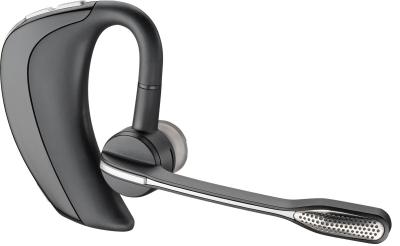Review: Plantronics Voyager Pro UC Bluetooth Headset

The Plantronics Voyager Pro UC provides enables callers to use the same Bluetooth headset for both mobile phone and PC-based unified communications systems.
The PerSono software is not strictly necessary, but it enables call control capability directly from the headset with supported softphones. The Voyager Pro UC will transmit and receive audio when used with an unsupported softphone, albeit without earpiece call control. For example, I tested the Voyager Pro UC in conjunction with the unsupported Vidyo Desktop. While I was able to get the headset to work with Vidyo – I could talk and hear the voice element of the video call – the call control buttons on the earpiece could not hang up the call.
Smartphone compatibility
The Voyager Pro UC also paired easily with both my test smartphones: an Apple iPhone 3GS and an Android 1.6-based T-Mobile G1 with Google. The earpiece call control and volume buttons worked seamlessly with both devices, allowing me to answer, drop or mute calls directly from the headset. When paired with the iPhone 3GS, the Voyager Pro UC also let me engage the iPhone’s voice search feature by holding down the call control button for a few seconds. This allowed me to take advantage of voice-activated dialing.
However, I could not listen to other audio via the Voyager Pro UC using either of my test smartphones. All local and streaming audio instead emanated from the smartphones’ speakerphones.
Sound quality
The sound quality delivered by the Voyager Pro UC’s dual microphones was quite impressive. Plantronics’ Audio IQ2 technology effectively removed overwhelming ambient noise. For example, remote callers reported that my voice quality was excellent with little background noise, even when I stood next to the server racks in eWEEK Labs’ very loud data centre. The microphones also employ stainless steel microphone screens and acoustic fabrics to tamp down any wind noise.
Received sound was also quite good, particularly when the headset was used with the PC. The Voyager Pro UC supports wideband audio for use with communications systems that support it. Skype calls sounded much clearer with wideband audio enabled (the toggle control can be found in the Settings – Dongle tab of the PerSono software), and music sounded significantly less flat and hollow.
Wideband audio puts a bigger drain on the battery than narrowband, although the hit isn’t as great as I anticipated. The Voyager Pro UC is rated for 6 hours of narrowband talk time, but that rating drops to 5 hours when configured for wideband. I found I could easily make it through an entire day on a single charge, although contact centre denizens who are on the phone constantly will likely need to top off the battery during the day.
I was also happy with the distance performance afforded by the Voyager Pro UC. The device is rated for operation up to 33 feet. During tests using the Voyager Pro UC and my iPhone, I could place the iPhone near a window in an empty office 20 feet away from my cubicle (where AT&T coverage and performance is typically terrible) and still send and receive calls.